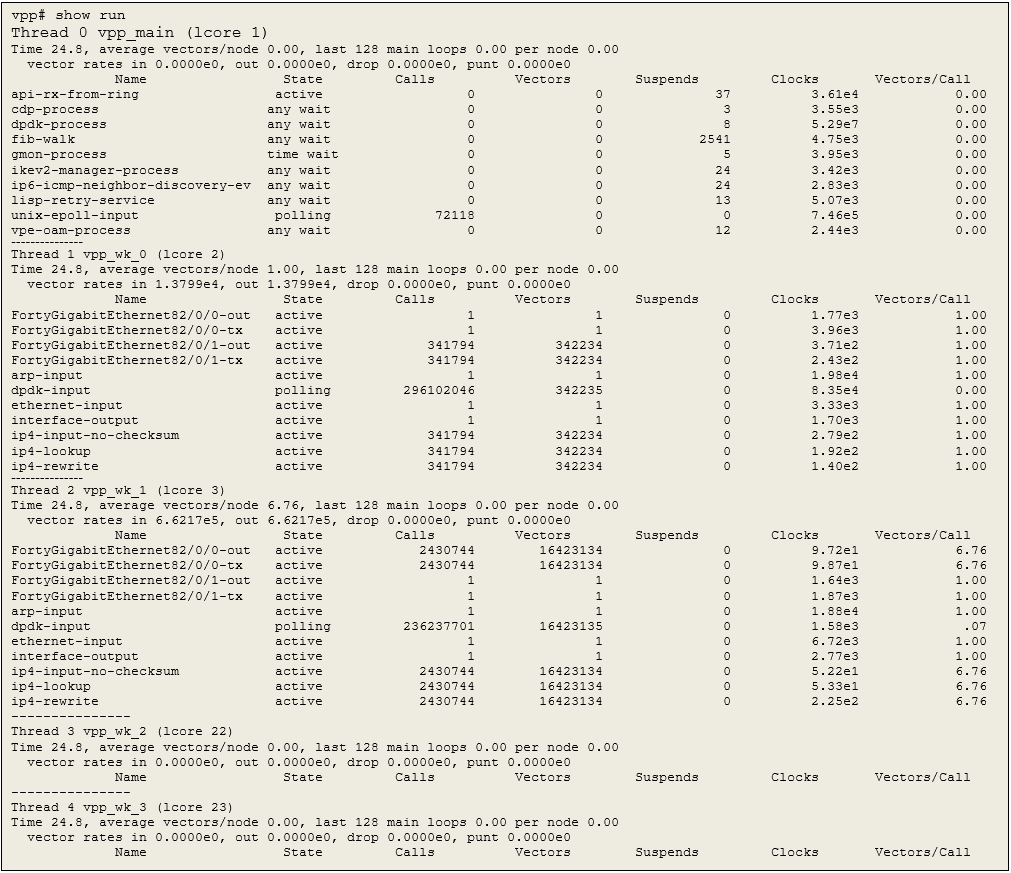Using VPP with Iperf3
First, disable kernel IP forward in csp2s22c03 to ensure the host cannot use kernel forwarding (all the settings in net2s22c05 and csp2s22c04 remain unchanged):
csp2s22c03$ echo 0 | sudo tee /proc/sys/net/ipv4/ip_forward
0
csp2s22c03$ sysctl net.ipv4.ip_forward
net.ipv4.ip_forward = 0
You can use DPDK’s device binding utility (./install-vpp-native/dpdk/sbin/dpdk-devbind) to list network devices and bind/unbind them from specific drivers. The flag “-s/–status” shows the status of devices; the flag “-b/–bind” selects the driver to bind. The status of devices in our system indicates that the two 40-GbE XL710 devices are located at 82:00.0 and 82:00.1. Use the device’s slots to bind them to the driver uio_pci_generic:
csp2s22c03$ ./install-vpp-native/dpdk/sbin/dpdk-devbind -s
Network devices using DPDK-compatible driver
============================================
<none>
Network devices using kernel driver
===================================
0000:03:00.0 'Ethernet Controller 10-Gigabit X540-AT2' if=enp3s0f0 drv=ixgbe unused=vfio-pci,uio_pci_generic *Active*
0000:03:00.1 'Ethernet Controller 10-Gigabit X540-AT2' if=enp3s0f1 drv=ixgbe unused=vfio-pci,uio_pci_generic *Active*
0000:82:00.0 'Ethernet Controller XL710 for 40GbE QSFP+' if=ens802f0d1,ens802f0 drv=i40e unused=uio_pci_generic
0000:82:00.1 'Ethernet Controller XL710 for 40GbE QSFP+' if=ens802f1d1,ens802f1 drv=i40e unused=uio_pci_generic
Other network devices
=====================
<none>
csp2s22c03$ sudo modprobe uio_pci_generic
csp2s22c03$ sudo ./install-vpp-native/dpdk/sbin/dpdk-devbind --bind uio_pci_generic 82:00.0
csp2s22c03$ sudo ./install-vpp-native/dpdk/sbin/dpdk-devbind --bind uio_pci_generic 82:00.1
csp2s22c03$ sudo ./install-vpp-native/dpdk/sbin/dpdk-devbind -s
Network devices using DPDK-compatible driver
============================================
0000:82:00.0 'Ethernet Controller XL710 for 40GbE QSFP+' drv=uio_pci_generic unused=i40e,vfio-pci
0000:82:00.1 'Ethernet Controller XL710 for 40GbE QSFP+' drv=uio_pci_generic unused=i40e,vfio-pci
Network devices using kernel driver
===================================
0000:03:00.0 'Ethernet Controller 10-Gigabit X540-AT2' if=enp3s0f0 drv=ixgbe unused=vfio-pci,uio_pci_generic *Active*
0000:03:00.1 'Ethernet Controller 10-Gigabit X540-AT2' if=enp3s0f1 drv=ixgbe unused=vfio-pci,uio_pci_generic *Active*
Start the VPP service, and verify that VPP is running:
csp2s22c03$ sudo service vpp start
csp2s22c03$ ps -ef | grep vpp
root 105655 1 98 17:34 ? 00:00:02 /usr/bin/vpp -c /etc/vpp/startup.conf
:w
105675 105512 0 17:34 pts/4 00:00:00 grep --color=auto vpp
To access the VPP CLI, issue the command sudo vppctl . From the VPP interface, list all interfaces that are bound to DPDK using the command show interface:
VPP shows that the two 40-Gbps ports located at 82:0:0 and 82:0:1 are bound. Next, you need to assign IP addresses to those interfaces, bring them up, and verify:
vpp# set interface ip address FortyGigabitEthernet82/0/0 10.10.1.1/24
vpp# set interface ip address FortyGigabitEthernet82/0/1 10.10.2.1/24
vpp# set interface state FortyGigabitEthernet82/0/0 up
vpp# set interface state FortyGigabitEthernet82/0/1 up
vpp# show interface address
FortyGigabitEthernet82/0/0 (up):
10.10.1.1/24
FortyGigabitEthernet82/0/1 (up):
10.10.2.1/24
local0 (dn):
At this point VPP is operational. You can ping these interfaces either from net2s22c05 or csp2s22c04. Moreover, VPP can forward packets whose IP address are 10.10.1.0/24 and 10.10.2.0/24, so you can ping between net2s22c05 and csp2s22c04. Also, you can run iperf3 as illustrated in the previous example, and the result from running iperf3 between net2s22c05 and csp2s22c04 increases to 20.3 Gbits per second.
ET2S22C05$ iperf3 -c 10.10.1.2
Connecting to host 10.10.1.2, port 5201
[ 4] local 10.10.2.2 port 54078 connected to 10.10.1.2 port 5201
[ ID] Interval Transfer Bandwidth Retr Cwnd
[ 4] 0.00-1.00 sec 2.02 GBytes 17.4 Gbits/sec 460 1.01 MBytes
[ 4] 1.00-2.00 sec 3.28 GBytes 28.2 Gbits/sec 0 1.53 MBytes
[ 4] 2.00-3.00 sec 2.38 GBytes 20.4 Gbits/sec 486 693 KBytes
[ 4] 3.00-4.00 sec 2.06 GBytes 17.7 Gbits/sec 1099 816 KBytes
[ 4] 4.00-5.00 sec 2.07 GBytes 17.8 Gbits/sec 614 1.04 MBytes
[ 4] 5.00-6.00 sec 2.25 GBytes 19.3 Gbits/sec 2869 716 KBytes
[ 4] 6.00-7.00 sec 2.26 GBytes 19.4 Gbits/sec 3321 683 KBytes
[ 4] 7.00-8.00 sec 2.33 GBytes 20.0 Gbits/sec 2322 594 KBytes
[ 4] 8.00-9.00 sec 2.28 GBytes 19.6 Gbits/sec 1690 1.23 MBytes
[ 4] 9.00-10.00 sec 2.73 GBytes 23.5 Gbits/sec 573 680 KBytes
- - - - - - - - - - - - - - - - - - - - - - - - -
[ ID] Interval Transfer Bandwidth Retr
[ 4] 0.00-10.00 sec 23.7 GBytes 20.3 Gbits/sec 13434 sender
[ 4] 0.00-10.00 sec 23.7 GBytes 20.3 Gbits/sec receiver
iperf Done.
The show run command displays the graph runtime statistics. Observe that the average vector per node is 6.76, which means on average, a vector of 6.76 packets is handled in a graph node.
